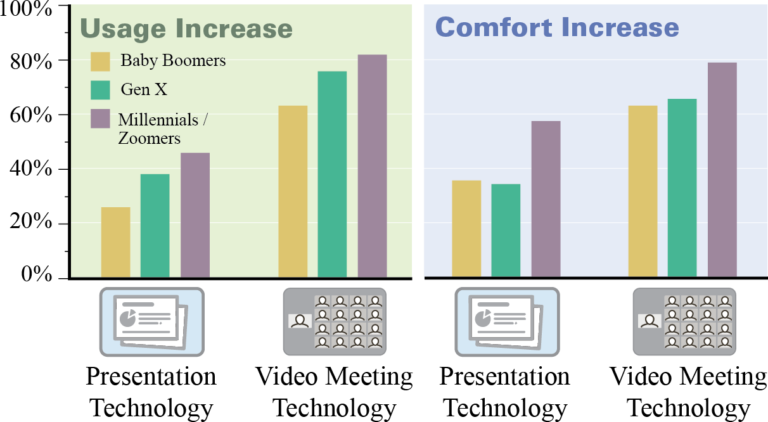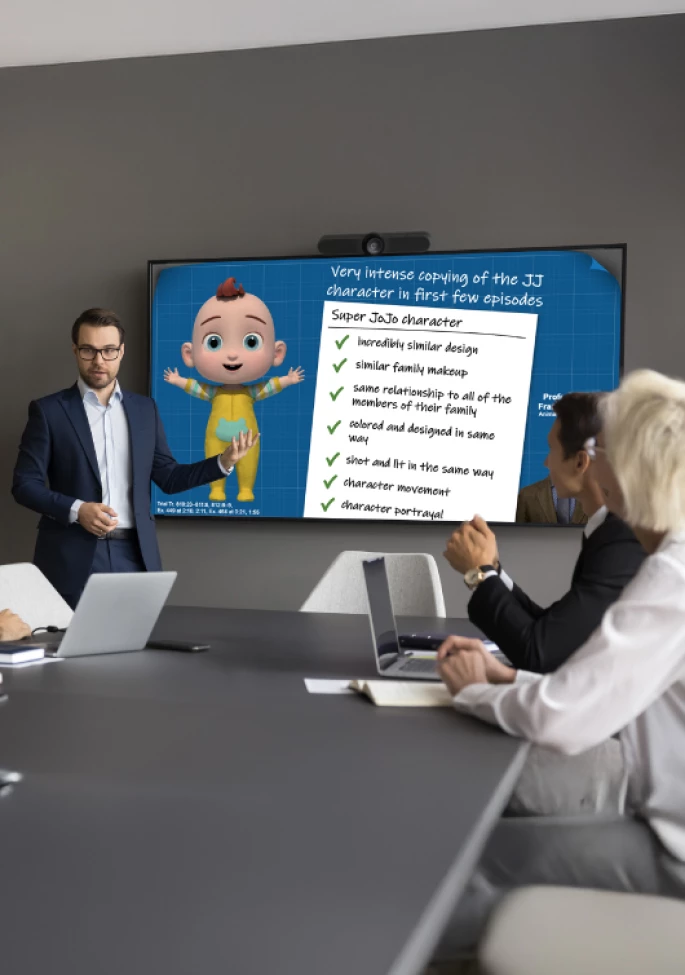Legal advocacy has changed. The pandemic has seen courts and parties adopting technology to depose witnesses, hold hearings and mediations, and conduct trials in all-virtual or “hybrid” environments (such as jury selection by Zoom and trial in person). As a result, the ways attorneys tell case stories have had to adapt to the unique situational factors of a courtroom that exists entirely online, or one that has been drastically modified to fit social-distancing guidelines.
If you are an attorney on one of the hundreds of cases pending as courts open in your jurisdiction, you may be breathing a sigh of relief. It is tempting to believe that an end to the pandemic will return things back to the way they were in the courtroom.
Don’t give in to that temptation quite yet. Some of the technological and physical changes that courts have implemented will live on in many courts, at least for the short term. And just as importantly, courts are not the only thing that has changed during the pandemic; they merely reflect what jurors have experienced in numerous facets of their lives.
A savvy attorney needs be aware of how jurors’ new experiences and expectations will impact their perceptions of your case in the post-pandemic world.
Persuasion Is an Evolving Art
To make a message persuasive, it must be relevant and timely. Ancient rhetoricians referred to the concept as kairos, the importance of time and setting when making arguments—in other words, the situational factors that impact an attempt to persuade.
Fast forward to our current pandemic: As you go forth to argue your case’s merits, it is rare to encounter a time so likely to have impacted the way juries view your case and how they make decisions.
To study these changes, we surveyed over 200 prospective jurors to learn more about their expectations and preferences. Not surprisingly, 80% indicated that they are at least somewhat comfortable using online video-conference tools such as Zoom. We also asked if it would be more difficult to pay attention to a trial that took place entirely online; 60% said it would be at least as easy to pay attention as it would be in person.
One very interesting finding is that, when presented with a choice to report for jury duty in person or via Zoom, more than half would choose jury duty online.
While there are any number of different practices courts are implementing to accommodate civil trials this year, it is clear that jurors have higher expectations that technology be used to make the experience better for them. In the post-pandemic courtroom, counsel should consider demonstrating a proficiency with these potential accommodations, from remote technology to the use of masks.
Accommodations Have Created New Difficulties
Of course, these accommodations are a double-edged sword. Indeed, from a juror’s perspective, one of the biggest challenges of sitting through an online or partially online civil trial has been tuning out all the new distractions. For remote jurors, these include the challenges of being at home (or in an office) and being required to focus for long stretches of time on a Zoom screen.
For example, 67% of those we surveyed said it is harder to judge other people’s body language in a video meeting than an in-person meeting. And jurors don’t fare much better in the hybrid trial, where the modified courtrooms place parties at safe distances, often with jurors farther away from witnesses and counsel. Add in the now-ubiquitous plexiglass dividers and the fact that everyone is wearing masks, and it is easy to see how these changes add up to a challenging and uncomfortable experience for our jurors.
It is up to trial counsel to help a jury overcome some of these challenges, and it starts with trial preparation. From the beginning, counsel should emphasize the integration of themes and demonstratives that help keep the jury engaged in this distraction-prone courtroom environment.
Key Themes Are More Important Than Ever
We have long advocated using key themes for trial advocacy, and they are more important than ever in a courtroom filled with potential distractions.
Themes are more than just pithy statements—they should reflect a key message or idea about your case that your juror supporters can easily remember and use to argue for your case in deliberation. Your themes should tie to evidence in your case and should be repeatable by witnesses in their testimony. Jurors will better assimilate your case messages through themes that are identifiable and repeated often.
For instance, in a recent wrongful death case involving a snowplow, the driver and expert established the concept that “You Cannot Avoid What You Cannot See.” This theme helped persuade jurors that despite the best practices of the driver, a pedestrian who was not exercising necessary care can be struck and killed by walking in the plow’s blind spot.
Memorable themes tailored to your case, such as “Safe When Used Safely” or “Dose Makes the Difference” or “A Time-Tested Product,” will help juries go to bat for you in deliberations, especially when they are repeated often enough that jurors can recall them easily.
Witnesses Will Require Special Preparation
Your next significant consideration should be working with witnesses to incorporate those themes and to present as credibly as possible, whether via Zoom or in a modified courtroom. And while 66% of our respondents said they would find a witness who testified via video just as credible as one who testified in person, an online witness still poses a challenge to trial practice.
For instance, in the pre-pandemic courtroom, witnesses were handed documents and exhibits (sometimes for the very first time) on the stand. These exhibits had the capacity to surprise and confound a witness, a potentially significant sign to a jury that the witness is not credible. On Zoom, it is more difficult for an attorney to “surprise” a witness; at the same time, however, any facial reaction a witness has will be magnified for the jury.
Consider a recent example of a witness testifying via Zoom, who was projected live into the courtroom on a screen large enough to be seen across the conference center. When opposing counsel asked a question, the expert rolled her eyes. What would have been a subtle expression under normal circumstances was caught easily by every member of the jury.
In short, there are trade-offs to consider when preparing witnesses. Preparation should not only incorporate relevant themes, but also nonverbal communication tips and technology training so the witness is comfortable with the format they will rely on to testify.
Creative Demonstratives Reinforce Your Themes & Keep Jurors Engaged
Finally, you can reinforce your themes through creative and engaging visual aids that work in every setting, including Zoom trials. In our recent survey, participants reported increased use of video-conference platforms and other types of presentation technology since the start of COVID-19 (51% of potential jurors said their use of presentation technologies, such as PowerPoint, had increased since the start of COVID-19; 75% of potential jurors indicated their use of video-meeting technology, such as Zoom, had increased.)
And not only have jurors indicated a general comfort with video-conference tools (as previously noted), but they also reported specifically that their comfort with such technologies has increased during the pandemic (55% of potential jurors stated their comfort with presentation technologies, such as PowerPoint, had increased; 72% said their comfort with video-meeting technology, such as Zoom, had increased). Even more interesting, this change was consistent across age groups, as you can see in the following chart:
Increase in Use/Comfort by Percentage

So, while the common stereotype may hold true that Millennials (along with the newest generation reaching juror eligibility, Zoomers) “need” visuals, older jurors such as Baby Boomers are not far behind. With a more technology-savvy population comes higher expectations for media presentations in the post-pandemic courtroom.
This shift is further reinforced by our survey, where jurors indicated they expected attorneys to use some sort of visual aid when presenting their case (56% of potential jurors expected an attorney to use PowerPoint in presenting their case; 64% said they would expect attorneys to use creative graphics and videos to illustrate their case). Jurors in our mock trial exercises echo this sentiment, frequently expressing that they wish they could “see” what the attorneys were talking about or mentioning they had trouble visualizing exactly what the scene of an accident looks like.
Even beyond jurors’ expectations, demonstratives are helpful in opening and closing to bolster the themes introduced during witness testimony and oral arguments. The added repetition aids jurors’ recollection, and the visual format provides an effective medium for those with a more visual learning style.
From our experiences in both Zoom trials and hybrid trials, there are several important considerations when incorporating demonstratives into a presentation:
First, consider how the demonstratives will be shown to jurors. Will jurors view them online via their computer screens? Will they be projected onto a screen in the courtroom? If the demonstrative is presented online, remember that jurors will have a much closer view of the information than they would if it were projected in a physical courtroom.
For example, pulling a designation from an email and projecting it on a courtroom screen makes it difficult for jurors to read the parts of the email that are not being magnified. That same designation presented online is much closer to the juror, so additional information is likely to be noticed. As such, it is important to think about what exactly you want jurors to focus (or not focus) on.
Second, when demonstratives are pulled up on Zoom, the image frequently obscures the presenting attorney. Therefore, be especially selective in the number of demonstratives used in opening and closing, focusing on quality over quantity. The attorney will get more screen time as they make their arguments, and jurors will have a curated set of the most crucial themes and evidence to remember.
Conclusion
Although many courts have reopened and others should soon follow, the ripples of the pandemic lockdown are likely to resonate for some time. And with the rise in technology comfort and the strong potential for distractions among remote jurors, certain preparations are more important than ever. Develop clear themes to convey your case, incorporate those themes into witness testimony, and use demonstratives strategically to emphasize your case message.
Ultimately, you will find an advantage in embracing the enduring technological changes and juror expectations of the post-pandemic world.
This article was co-authored by the late Dr. Katrina Cook, a beloved member of the IMS jury consulting team. A version first appeared in the Summer 2021 issue of USLAW Magazine.







